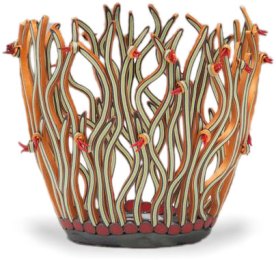Mokume gane treat

This brooch by France’s Isabelle Chatelain speaks to me and it’s too delicious to just let it float by on Flickr. Let’s grab it and mull it over for a Friday minute.
The repeating circle patterns both change and stay the same. This is polymer mokume gane at its best and the color combination shows off the pattern nicely. It hints at Moorish mosaics and Byzantine ceilings.

Isabelle mixes bits of this design into other brooches. Her ability to assemble compositions from small chunks of mokume gane plus textures and colored shapes is remarkable. Yummy.
Find more on Facebook and in her online shop. Isabelle also teaches on CraftArtEdu.
















